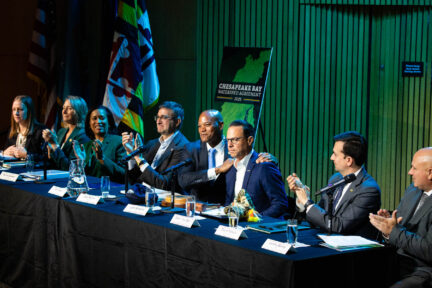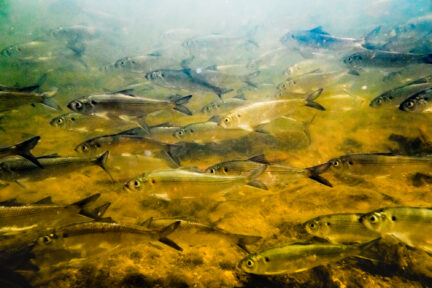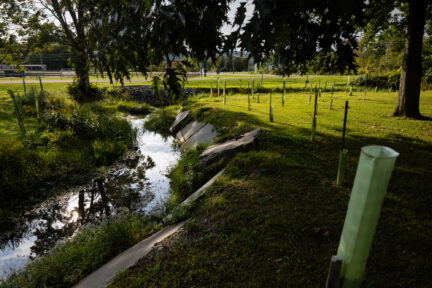Local, state and federal agencies open 22 public access sites in Chesapeake Bay region
The Chesapeake Bay Program is pleased to announce that in 2015, our partners opened 22 boat ramps, fishing piers and other sites that grant public access to creeks, streams and rivers in the region.
The Chesapeake Bay Program is pleased to announce that in 2015, our partners opened 22 boat ramps, fishing piers and other sites that grant public access to creeks, streams and rivers in the region. Virginia opened 10 sites along eight waterways; Pennsylvania opened six sites along the Susquehanna River; Maryland opened five sites along three waterways; and the District of Columbia opened one site along the Anacostia River. There are now 1,247 public access sites in the watershed for boating, fishing, swimming and other recreational activities. In celebration of its 100th anniversary, the National Park Service—a Chesapeake Bay Program partner—encourages people to visit parks of all kinds to connect with history and culture and enjoy the natural world.
The varied ownership of the region’s public access sites demonstrates the importance of establishing strong partnerships and public access initiatives at all levels of government and with nongovernmental organizations: nine of the new sites are owned by local governments, nine are owned by state governments, two are owned by the federal government and two are owned by nongovernmental organizations.
Increasing public access to open space and waterways creates a shared sense of responsibility to protect these important natural environments. Through the Chesapeake Bay Watershed Agreement, our partners have committed to increasing public access as part of a larger effort to engage communities in our conservation work. The number of public access sites in the Chesapeake Bay watershed is on track to reach 1,439 by 2025. Since tracking began in 2010, our partners have opened 108 sites, meeting 36 percent of our goal to open 300 sites over the next decade.
Facts
In 2015, 22 new access sites were opened to the public. Virginia opened 10 sites, Pennsylvania opened six sites, Maryland opened five sites and the District of Columbia opened one site. This brings the total number of access sites in the Chesapeake Bay watershed to 1,247.
| Site | Water Body | County | Description |
|---|---|---|---|
| Crow's Nest Natural Area Preserve | Accokeek Creek | Stafford | Boating (with ADA accessible paddle craft access) |
| Menokin Landing | Cat Point Creek | Richmond | Boating (with paddle craft access) |
| Fort Young Park | Jackson River | Alleghany | Boating (with paddle craft access) |
| Glen Wilton Park | James River | Botetourt | Boating (with paddle craft access) |
| James River Beach Park | James River | James City | Beach use, boating (with paddle craft access) and swimming |
| King and Queen County Fishing Pier | Mattaponi River | King and Queen | Fishing (with pier) |
| Lake Ridge Marina | Occoquan River | Prince William | Boating (with ADA accessible paddle craft access) |
| Leesylvania State Park | Potomac River | Prince William | Boating (with paddle-in access for camping) |
| Westmoreland State Park | Potomac River | Westmoreland | Boating (with paddle-in access for camping) |
| Port Royal Landing | Rappahannock River | Caroline | Boating and fishing (with paddle craft access and ADA accessible fishing pier) |
| Site | Water Body | County | Description |
|---|---|---|---|
| Black Walnut River Island Campsite | Susquehanna River | Wyoming | Fishing, camping and viewing |
| Exeter River Island Campsite | Susquehanna River | Luzerne | Fishing, camping and viewing |
| Falls River Island Campsite | Susquehanna River | Wyoming | Fishing, camping and viewing |
| Jersey Shore Boat Launch | Susquehanna River | Lycoming | Boating (with ADA accessible boat launch and floating dock), fishing and viewing |
| Meehoopany North River Island Campsite | Susquehanna River | Wyoming | Fishing, camping and viewing |
| Meehoopany South River Island Campsite | Susquehanna River | Wyoming | Fishing, camping and viewing |
| Site | Water Body | County | Description |
|---|---|---|---|
| Kiwanis Park | Antietam Creek | Washington | Boating (with soft launch on shoreline) |
| Molly's Hole | Antietam Creek | Washington | Boating (with soft launch on shoreline) |
| Phillip's Wharf Environmental Center | Knapps Narrows | Talbot | Boating (with concrete slabs for small motorized and non-motorized vessels) |
| Beachwood Park | Magothy River | Anne Arundel | Boating (with soft launch on shoreline) |
| Spriggs Farm Park | Magothy RIver | Anne Arundel | Boating (with soft launch on shoreline) |
| Site | Water Body | County | Description |
|---|---|---|---|
| Kingman Island Park | Anacostia River | District of Columbia | Boating (with dock for canoes and kayaks), fishing and viewing |
Issues
As development continues across the Chesapeake Bay watershed, demand for places that allow the public to reach the water remains high. State, federal and local governments are often the guardians of these places, providing opportunities for everyone to enjoy the region’s natural and cultural bounty. Because physical access to the Bay and its tributaries remains limited—with real consequences for quality of life, the economy and long-term conservation—Chesapeake Bay Program partners set a goal to bring the total number of access sites in the watershed to 1,439 by 2025.
Importance
Public access to open space and waterways can improve public health and quality of life. People rely on outdoor places to exercise, relax and revive their spirits. Time outdoors can strengthen family bonds and nurture active, creative children. And access to the Chesapeake Bay and its tributaries can build personal connections with the places that have shaped life in the region for centuries. This has a distinct economic and environmental value, as it boosts tourism and creates citizen stewards who care for local resources and engage in the conservation of the Bay and its many resources.
Quotes
“The Chesapeake Bay watershed has almost 12,000 miles of shoreline and over 150 major rivers and streams. It is critically important that the public have access to these waters for swimming, boating, fishing and wildlife observation, and the opportunity to benefit from the physical, mental and spiritual renewal they provide. Connecting with the natural world is essential to our well-being as individuals and as a society.”
--Nick DiPasquale, Director, Chesapeake Bay Program
“When we make Gateways financial assistance awards to help our partners build access, we fulfill the National Park Service’s mission to provide for the enjoyment of this national treasure for current and future generations.”
--Chuck Hunt, Superintendent, National Park Service Chesapeake Bay Office and Chair, Chesapeake Bay Program's Fostering Stewardship Goal Implementation Team
“As the state with the most public water access points in the Chesapeake Bay watershed, Maryland will continue to seek out innovative partnerships to create, enhance and improve water access so more of our citizens can enjoy the beauty and bounty of the Bay. Expanding public access, either through creating new access points or improving existing sites, is a worthwhile goal for Bay restoration, our citizens and the state.”
--Mark Belton, Secretary of Natural Resources, Maryland Department of Natural Resources
“To conserve and restore the Chesapeake Bay, we need public access so that we can get people’s feet wet and their eyes open. People need to experience the Chesapeake to care deeply about it. We applaud the land managers and the people who work together to create public access such as paddle-in campsites, fishing piers, boat launches and more. All of these projects happen because there is community interest and resolve to see them through. Some have corporate support from companies such as REI. Most have local, state, federal or nonprofit funding support; and many rely on all of these partners to make projects happen.”
Joel Dunn, President and CEO, Chesapeake Conservancy



